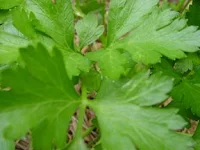Parsley of Old – My Old Anyway
 Parsley was the first fresh herb I was familiar with as a child. It was present at almost every restaurant prepared meal, sitting on the plate next to a slice of lemon or carrot curl. My mother always urged me in a whisper after every meal to eat my parsley because it was nature’s breath freshener. The variety I was most familiar with was curly, but not quite as tightly curled as the parsley we now see in stores or available for planting in most plant outlets in spring.
Parsley was the first fresh herb I was familiar with as a child. It was present at almost every restaurant prepared meal, sitting on the plate next to a slice of lemon or carrot curl. My mother always urged me in a whisper after every meal to eat my parsley because it was nature’s breath freshener. The variety I was most familiar with was curly, but not quite as tightly curled as the parsley we now see in stores or available for planting in most plant outlets in spring.Parsley Facts
Parsley was also the first herb that I came across that was biennial. It has a two-year life cycle, setting seed in spring of the second year the way an annual would set seed in the summer or fall of the first year. Parsley makes a good indoor plant if you can give it enough light.
Parsley Seeds
Parsley has small seeds that can be hard to get to germinate. Before you plant them out, try soaking them for a few hours in hot water. Once planted, keep them warm.
Drying Parsley
I have used parsley in herb wreaths, but I have never been satisfied with its color or texture as a decorative herb, so I dry most of my fall crop in a dehydrator, grinding it to give away in Christmas herb blends, the rest I keep in the ground for next year’s seed.

Comments
Post a Comment
Share some ideas.